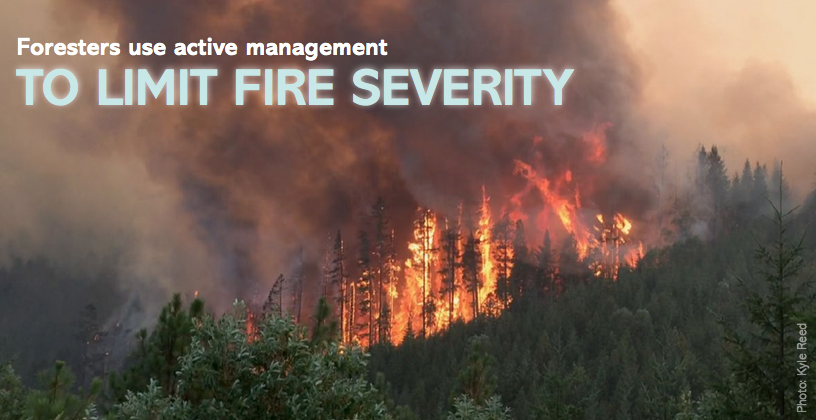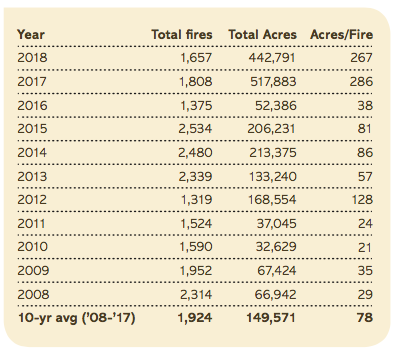Foresters use active management to limit fire severity

Fire is a natural part of Oregon’s forest ecosystems. Before European settlement, res burned through the dry pine forests of central and eastern Oregon and the mixed-conifer forests of southwestern Oregon every two to 50 years. The wetter, Douglas- fir forests of western Oregon once burned every 200 years or longer.
When regular, low-intensity fires occurred in forests, they helped burn away smaller trees and brush that could serve as fuel for future wild res. As a result, when another fire burned through those same forests, it was less likely to become large and destructive.
But as Oregon’s population grew over the past century and the threat that fire posed to human life and property increased, fire ghters grew skilled at quickly putting out all wild res. Without frequent, smaller fires, Oregon’s dry forests grew unnaturally dense, creating the ideal conditions for more intense wild res.
Climate change is another reason Oregon’s wild re seasons are getting longer and the amount of forestland burned continues to grow. A warming climate has not only led to hotter, drier fire seasons, but it’s also contributed to more drought and insect outbreaks that can kill trees and make forests more susceptible to fire damage.
WILDFIRE IMPACTS
The high risk of “uncharacteristic” wildfires in many of Oregon’s forests, due to both a build-up of fuels and climate change, can lead to poor air and water quality, harm to fish and wildlife habitat, and negative impacts to Oregonians living across the state. The total acres of forestland burned in recent years has increased dramatically, threatening homes, causing hazardous smoke to drift into communities, and impacting everything from human health to tourism, transportation, and recreational opportunities.
MANAGING FOR FIRE RESILIENCY
Foresters and forest landowners are using an understanding of the historic role of fire to manage forests in a way that limits potential harm posed by wild res. This includes cutting down some trees so forests are less dense, and setting controlled burns—also called prescribed burns. By mimicking the role of natural fires, these techniques improve overall forest health and limit the severity of wild res when they do happen. Reducing the number of shrubs and small trees in an overcrowded forest is especially effective because they can serve as “ladder fuels,” allowing flames to climb quickly from the ground into the forest canopy and potentially kill even large trees. Providing access to forests by maintaining a road system also aids fire ghters in suppressing wildfires.
HOMES NEAR FORESTS
Along with climate change, another factor that has complicated recent fire seasons in Oregon is that more people are living close to forests, in what’s known as the wildland-urban interface. That’s why, in order to protect human lives, homes and other structures, it’s often necessary to suppress wild res. This is especially true for western Oregon forests, which not only have more people living near them but also produce the highest-value timber in the state.
FIGHTING FIRES
The Oregon Department of Forestry (ODF) serves as the fire department for 16 million acres of private and public forestland, including state forests and, by contract, the federal Bureau of Land Management (BLM) forests in western Oregon. The U.S. Forest Service maintains its own system to suppress fires on national forests. Forest landowners are required by law to provide protection from fire on their lands. Most opt to pay a fee to the state to have ODF provide fire protection for them. ODF strives to put out fires quickly and at the smallest possible size, to protect human lives and property as well as timber-producing forests that support Oregon’s economy. This is accomplished through a complete and coordinated system that brings together personnel and resources from other public agencies, private forest landowners and contractors to help ODF fight fires.
RECENT FIRE HISTORY AND TOTAL ACRES BURNED
The total number of forest fires in Oregon per year has remained fairly stable, but the total acres of forestland burned in recent years has increased dramatically. (Table includes Forest Service, state, private, tribal and BLM forestlands.)

WILDFIRE PREVENTION
Lightning sparks about a quarter of the wildfires in Oregon, but the leading cause is people, especially with an increasing number living near or recreating in the state’s forests. Major culprits for human-caused wildfires include backyard burn piles and unattended campfires. Fortunately, there are plenty of ways to prevent starting a wild re, such as making sure campfires are fully put out and only using fireworks away from anything flammable. To learn about preventing human-caused fires, go to keeporegongreen.org.
There are also a number of precautions homeowners can take to reduce the likelihood that a wildfire will spread to and destroy their property. These include creating a 30-foot defensible space around the home that is free of combustible material; cleaning up any dead or dying plants, branches and needles; and pruning nearby trees. For more information about creating a re-resilient home, visit firewise.org.


Advertisement